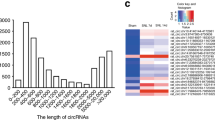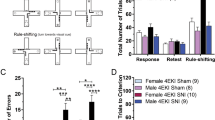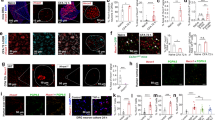Abstract
N-methyl-D-aspartate (NMDA) receptor activation, at the level of the spinal cord, has been shown to play an important role in the facilitation of nociception in several animal models. However, the use of NMDA antagonists as analgesics is limited by serious side effects due to nonselective effects among the NMDA receptor subtypes. Recent discoveries revealed that the transfection of small interfering RNAs (siRNAs) into animal cells resulted in the potent, long-lasting, post-transcriptional silencing of specific genes. Thus, we investigated the effect of intrathecal (i.t.) injection of siRNAs targeting NMDA-R2B receptor subunit protein (NR2B) receptors, a subunit of NMDA receptor, for the modulation of pain. The results indicate that the use of siRNA targeting the NR2B subunit not only decreased the expression of NR2B mRNA and its associated protein, as demonstrated by real-time PCR and Western blotting, but also abolished formalin-induced pain behaviors in rat model. The peak effect occurred on day 3 for mRNA and day 7 for its protein, following i.t. injection of 5 μg of siRNA-NR2B. These data prove the feasibility of i.t. siRNAs in the investigation of functional gene expression in the context of whole animal behavior for the management of chronic pain.
This is a preview of subscription content, access via your institution
Access options
Subscribe to this journal
Receive 12 print issues and online access
$259.00 per year
only $21.58 per issue
Buy this article
- Purchase on Springer Link
- Instant access to full article PDF
Prices may be subject to local taxes which are calculated during checkout





Similar content being viewed by others
References
Long SK, Smith DAS, Siarey RJ, Evans RH . Effect of 6-cyano-2,3,-dihy-droxy-7-nitro-quinoxaline (CNQX) on dorsal root-, NMDA-, kainate-, and quisqualate-mediated depolarization of rat motoneurones in vitro. Br J Pharmacol 1990; 100: 850–854.
Dickenson AH, Sullivan AF . Evidence for a role of the NMDA receptor in frequency dependent potentiation of deep rat dorsal horn nociceptive neurons following C fibre stimulation. Neuropharmacology 1987; 26: 1235–1238.
Watkins JC, Evans RH . Excitatory amino acid transmitters. Ann Rev Pharmacol Toxicol 1981; 21: 165–204.
Meller ST, Dykstra C, Gebhart GF . Production of endogenous nitric oxide and activation of soluble guanylate cyclase are required for N-methyl-D-aspartate produced facilitation of the nociceptive tail-flick reflex. Eur J Pharmacol 1992; 214: 93–96.
Sorkin LS et al. Neural changes in acute arthritis in monkeys. IV. Time-course of amino acid release into the lumbar dorsal horn. Brain Res Rev 1992; 17: 39–50.
Coderre TJ, Melzack R . The contribution of excitatory amino acids to central sensitization and persistent nociception after formalin-induced tissue injury. J Neurosci 1992; 12: 3665–3670.
Kutsuwada T et al. Molecular diversity of the NMDA receptor channel. Nature 1992; 358: 36–41.
Masuko T et al. A regulatory domain (R1–R2) in the amino terminus of the N-methyl-D-aspartate receptor: effects of spermine, protons, and ifenprodil, and structural similarity to bacterial leucine/isoleucine/valine binding protein. Mol Pharmacol 1999; 55: 957–969.
Monyer H et al. Developmental and regional expression in the rat brain and functional properties of four NMDA receptors. Neuron 1994; 12: 529–540.
Boyce S et al. Selective NMDA NR2B antagonists induce antinociception without motor dysfunction: correlation with restricted localization of NR2B subunit in dorsal horn. Neuropharmacology 1999; 38: 611–623.
Elbashir SM et al. Duplexes of 21-nucleotide RNAs mediate RNA interference in cultured mammalian cells. Nature 2001; 411: 494–498.
Elbashir SM, Lendeckel W, Tuschl T . RNA interference is mediated by 21- and 22-nucleotide RNAs. Genes Dev 2001; 15: 188–200.
Fire A et al. Potent and specific genetic interference by double-stranded RNA in Caenorhabditis elegans. Nature 1998; 391: 806–811.
Crawley JN, Paylor R . A proposed test battery and constellations of specific behavioral paradigms to investigate the behavioral phenotypes of transgenic and knockout mice. Horm Behav 1997; 31: 197–211.
Schobitz B et al. Centrally administered oligodeoxynucleotides in rats: occurrence of non-specific effects. Eur J Pharmacol 1997; 331: 97–107.
Montgomery MK, Xu S, Fire A . RNA as a target of double-stranded RNA-mediated genetic interference in Caenorhabditis elegans. Proc Natl Acad Sci USA 1998; 95: 15502–15507.
Kennerdell JR, Carthew RW . Use of dsRNA-mediated genetic interference to demonstrate that frizzled and frizzled 2 act in the wingless pathway. Cell 1998; 95: 1017–1026.
Svoboda P, Stein P, Hayashi H, Schultz RM . Selective reduction of dormant maternal mRNAs in mouse oocytes by RNA interference. Development 2000; 127: 4147–4156.
Sui G et al. DNA vector-based RNAi technology to suppress gene expression in mammalian cells. Proc Natl Acad Sci USA 2002; 99: 5515–5520.
Miyagishi M, Taira K . U6 promoter driven siRNAs with four uridine 3′ overhangs efficiently suppress targeted gene expression in mammalian cells. Nat Biotechnol 2002; 20: 497–500.
Lee NS et al. Expression of small interfering RNAs targeted against HIV-1 rev transcripts in human cells. Nat Biotechnol 2002; 20: 500–505.
Woolf CJ, Costigan M . Transcriptional and posttranslational plasticity and the generation of inflammatory pain. Proc Natl Acad Sci USA 1999; 96: 7723–7730.
Chen L, Huang LY . Protein kinase C reduces Mg2+ block of NMDA-receptor channels as a mechanism of modulation. Nature 1992; 356: 521–523.
Woolf CJ, King AE . Dynamic alterations in the cutaneous mechano-receptive fields of dorsal horn neurons in the rat spinal cord. J Neurosci 1990; 10: 2717–2726.
Torebjork HE, Lundberg LE, LaMotte RH . Central changes in processing of mechanoreceptive input in capsaicin-induced secondary hyperalgesia in humans. J Physiol (Lond) 1992; 448: 765–780.
McCall WD, Tanner KD, Levine JD . Formalin induces biphasic activity in C-fibers in the rat. Neurosci Lett 1996; 208: 45–48.
Puig S, Sorkin LS . Formalin-evoked activity in identified primary afferent fibers: systemic lidocaine suppresses phase 2 activity. Pain 1996; 64: 345–355.
Dubuisson D, Dennis SG . The formalin test: a quantitative study of the analgesic effects of morphine, meperidine, and brain stem stimulation in rats and cats. Pain 1977; 4: 161–174.
Song E et al. RNA interference targeting Fas protects mice from fulminant hepatitis. Nat Med 2003; 9: 347–351.
Huh KH, Wenthold RJ . Turnover analysis of glutamate receptors identifies a rapidly degraded pool of the N-methyl-D-aspartate receptor subunit, NR1, in cultured cerebellar granule cells. J Biol Chem 1999; 274: 151–157.
Hemmings-Mieszczak M et al. Independent combinatorial effect of antisense oligonucleotides and RNAi-mediated specific inhibition of the recombinant rat P2X3 receptor. Nucleic Acids Res 2003; 31: 2117–2126.
Elbashir SM, Harborth J, Weber K, Tuschl T . Analysis of gene function in somatic mammalian cells using small interfering RNAs. Methods 2002; 26: 199–213.
Sørensen DR, Leirdal M, Sioud M . Gene silencing by systemic delivery of synthetic siRNAs in adult mice. J Mol Biol 2003; 327: 761–766.
Godbey WT, Wu KK, Mikos AG . Tracking the intracellular path of poly(ethyleneimine)/DNA complexes for gene delivery. Proc Natl Acad Sci USA 1999; 96: 5177–5181.
Fabre V et al. Homeostatic regulation of serotonergic function by the serotonin transporter as revealed by nonviral gene transfer. J Neurosci 2000; 20: 5065–5075.
Ferrari S et al. Polyethyleneimine shows properties of interest for cystic fibrosis gene therapy. Biochim Biophys Acta 1999; 1447: 219–225.
Demeneix B et al. Gene transfer with lipospermines and polyethyleneimines. Adv Drug Deliv Rev 1998; 30: 85–95.
Ohkawa J, Taira K . Control of the functional activity of an antisense RNA by a tetracycline-responsive derivative of the human U6 snRNA promoter. Hum Gene Ther 2000; 11: 577–585.
Goula D et al. Size, diffusibility and transfection performance of linear PEI/DNA complexes in the mouse central nervous system. Gene Therapy 1998; 5: 712–717.
Zimmermann M . Ethical guidelines for investigations of experimental pain in conscious animals. Pain 1983; 16: 109–110.
Yaksh TL, Rudy TA . Analgesia mediated by a direct spinal action of narcotics. Physiol Behav 1976; 17: 1031–1036.
Hargreaves K et al. A new and sensitive method for measuring thermal nociception in cutaneous hyperalgesia. Pain 1988; 32: 77–88.
Yukhananov R, Guan J, Crosby G . Antisense oligonucleotide to N-methyl-D-aspartate receptor subunits attenuate formalin-induced nociception in the rat. Brain Res 2002; 930: 163–169.
Acknowledgements
This work was supported in parts by the University Integration Program from the Ministry of Education and by National Science Council Grant NSC 92-2314-B-182A-141.
Author information
Authors and Affiliations
Rights and permissions
About this article
Cite this article
Tan, PH., Yang, LC., Shih, HC. et al. Gene knockdown with intrathecal siRNA of NMDA receptor NR2B subunit reduces formalin-induced nociception in the rat. Gene Ther 12, 59–66 (2005). https://doi.org/10.1038/sj.gt.3302376
Received:
Accepted:
Published:
Issue Date:
DOI: https://doi.org/10.1038/sj.gt.3302376
Keywords
This article is cited by
-
Intranasal delivery of siRNA targeting NR2B attenuates cancer-associated neuropathic pain
Journal of Pharmaceutical Investigation (2024)
-
AKAP150 and its Palmitoylation Contributed to Pain Hypersensitivity Via Facilitating Synaptic Incorporation of GluA1-Containing AMPA Receptor in Spinal Dorsal Horn
Molecular Neurobiology (2021)
-
Silencing of spinal Trpv1 attenuates neuropathic pain in rats by inhibiting CAMKII expression and ERK2 phosphorylation
Scientific Reports (2019)
-
Neuroprotective potential of crocin against malathion-induced motor deficit and neurochemical alterations in rats
Environmental Science and Pollution Research (2018)
-
Silencing Myostatin Using Cholesterol-conjugated siRNAs Induces Muscle Growth
Molecular Therapy - Nucleic Acids (2016)



